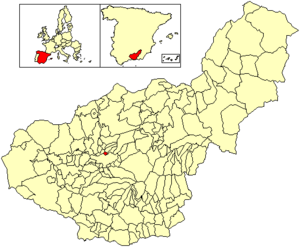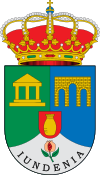Jun, Granada facts for kids
Quick facts for kids
Jun
|
|||
|---|---|---|---|
|
|||
 |
|||
| Country | Spain | ||
| Autonomous community | Andalusia | ||
| Province | Granada | ||
| Area | |||
| • Total | 3.69 km2 (1.42 sq mi) | ||
| Elevation | 755 m (2,477 ft) | ||
| Population
(2018)
|
|||
| • Total | 3,785 | ||
| • Density | 1,025.7/km2 (2,657/sq mi) | ||
| Time zone | UTC+1 (CET) | ||
| • Summer (DST) | UTC+2 (CEST) | ||
Jun is a small town and area in Spain. It is located in the north-central part of the Vega de Granada region. This area is in the province of Granada, which is part of the Andalucía community. Jun is close to other towns like Pulianas, Granada, Alfacar, and Víznar.
The area of Iundenia includes Jun, Baltodano, and two streets from Pulianas. These streets are called c/ Alhambra and c/ Generalife. Jun is found at the bottom of the Sierra de la Alfaguara mountains, near the Juncaril river.
Contents
People Living in Jun
How Many People Call Jun Home?
In 2014, the National Institute of Statistics of Spain reported that 3,661 people lived in Jun. This number helps us understand the size of the community.
Getting Around Jun
Roads and Connections
A major highway called El Distribuidor Norte de Granada (also known as Ronda Norte) passes through Jun. This highway connects two other important highways: the A-44 (which goes from Bailén to Motril) and the A-92 (which goes from Murcia/Almería to Sevilla).
There is also a local road, GR-3103. This road links Jun directly to the center of Granada. It connects to areas like Cartuja and Parque Nueva Granada. The GR-3103 also provides a route to the town of Alfacar.
Jun's Special Culture
Art and Industry in Jun
Today, Jun has factories that make ceramic products for building. However, the town is also known for its artistic use of ceramics. This means people create beautiful art pieces from clay.
How Technology Changed Jun
Jun is famous for using internet technology a lot. Both the people living there and the local government use it widely. In December 1999, the town announced that every citizen had the right to have internet at home.
In 2001, Jun held its first "interactive municipal council." This was a meeting where citizens could take part using technology. Because of this, Romano Prodi, who was the head of the European Commission at the time, called Jun the "birthplace of interactive democracy." This means Jun was a pioneer in letting citizens participate in government decisions through technology.
Today, Jun's local government is still working to be modern. They want to give residents free access to software. The city council also uses social media, especially Twitter, to talk with citizens. This makes it easier for people to communicate with their local government.
Famous People from Jun
Notable Iundenenses
- Antonio Marín Ocete (1900-1972) was an important person from Jun. He was the rector (the main leader) of the University of Granada. He was also one of the attorneys (legal representatives) for the Cortes Españolas, which was a type of parliament in Spain.
Jun's Sister Cities
Connecting with Other Towns
Jun has special connections with other cities around the world. These are called "twinnings."
See also
 In Spanish: Jun para niños
In Spanish: Jun para niños



